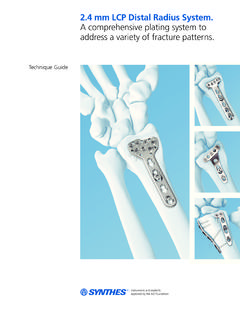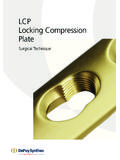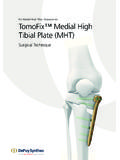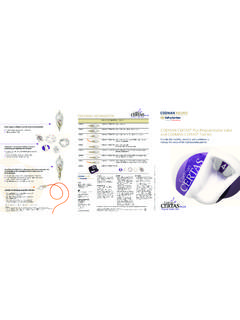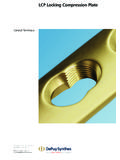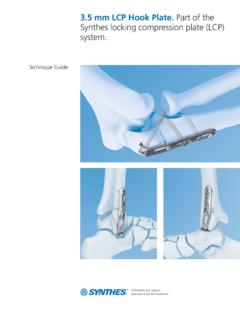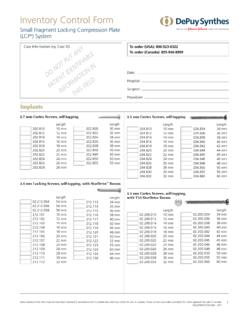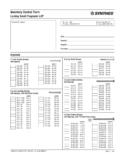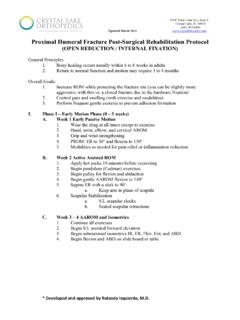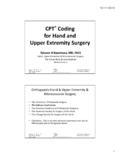Transcription of PFNA-II. Proximal Femoral Nail Antirotation.
1 PFNA-II. Proximal Femoral Nail TechniqueThis publication is not intended for distribution in the and implants approved by the AO intensifier controlThis description alone does not provide sufficient background for direct use of DePuy Synthes products. Instruction by a surgeon experienced in handling these products is highly , Reprocessing, Care and MaintenanceFor general guidelines, function control and dismantling of multi-part instruments, as well as processing guidelines for implants, please contact your local sales representative or refer to: general information about reprocessing, care and maintenance of Synthes reusable devices, instrument trays and cases, as well as processing of Synthes non-sterile implants, please consult the Important Information leaflet (SE_023827) or refer to.
2 Surgical Technique DePuy Synthes 1 Table of ContentsIntroduction Introduction 2 AO Principles 5 Indications and Contraindications 6 Clinical Cases 7 Surgical Technique Preoperative Planning 8 Patient Positioning 9 Preparation 10 Open Femur 14 Insert Nail 19 Proximal Locking 22 Distal Locking 40 For PFNA-II Short 42 For PFNA-II Long 48 Insert End Cap 51 Implant Removal 53 Correction of Insertion Depth of PFNA-II Blade 56 Cleaning 57 Product Information Implants 58 Alternative Implants 64 Instruments 66 Cases 75 MRI Information
3 792 DePuy Synthes PFNA-II Surgical TechniquePFNA-II. Proximal Femoral Nail Antirotation NailSeveral distal locking optionsStatic or dynamic locking can be per-formed via the aiming arm with PFNA-II standard, small and xs. The PFNA-II long additionally allows for secondary PFNA-II has a medial-lateral angle of 5 This allows insertion at the tip of the greater shortPFNA-II longStaticDynamicStaticDynamicStatic (90 )PFNA-II Surgical Technique DePuy Synthes 3 PFNA-II NailProduct rangeThe PFNA-II is available in 4 sizesPFNA-II long, length 260 340 mm (with 20 mm increments), length 340 420 mm (with 40 mm increments, only B 10 mm nails)
4 , bending radius 1500 mmPFNA-II, length 240 mmPFNA-II small, length 200 mmPFNA-II xs, length 170 mm4 DePuy Synthes PFNA-II Surgical TechniqueRotational and angular stability achieved with one single elementCompaction of cancellous boneInserting the PFNA-II blade compacts the cancellous bone providing additional anchoring, which is especially important in osteoporotic Proximal Femoral Nail BladeBone structure after PFNA-II blade inser tion cancellous bone is compacted providing additional anchoring to the PFNA-II surface and increasing core diameter for maximum compaction and optimal hold in boneIncreased stability caused by bone compaction around the PFNA-II blade has been biomechanically proven to retard rotation and varus collapse.
5 Biomechanical tests have demonstrated that the PFNA-II blade had a significantly higher cut-out resistance in comparison with commonly-used screw locking of the PFNA-II blade All surgical steps required to insert the PFNA-II blade are performed through lateral incision The PFNA-II blade is automatically locked to prevent rotation of the blade and Femoral headPFNA-II blade unlockedPFNA-II blade lockedBone structure before insertion of the PFNA-II Amir A. Al-Munajjed, Joachim Hammer, Edgar Mayr, Michael Nerlich and Andreas Lenich. Biomechanical characterization of osteosyntheses for Proximal fractures: helical blade versus screw.
6 Medicine Meets Engineering. 20082 Data on Surgical Technique DePuy Synthes 5AO Principles 1 M ller ME, Allg wer M, Schneider R, Willenegger H. Manual of Internal fixation . 3rd ed. Berlin, Heidelberg, New York: Springer. 1991. 2 R edi TP, Buckley RE, Moran CG. AO Principles of fracture Management. 2nd ed. Stuttgart, New York: Thieme. 1 12:084 DePuy Synthes Expert Lateral Femoral Nail Surgical TechniqueAO PRINCIPLESIn 1958, the AO formulated four basic principles, which have become the guidelines for internal fixation1, M ller ME, M Allg wer, R Schneider, H Willenegger. Manual of Internal fixation .
7 3rd ed. Berlin Heidelberg New York: Springer. R edi TP, RE Buckley, CG Moran. AO Principles of fracture Management. 2nd ed. Stuttgart, New York: Thieme. reductionFracture reduction and fixation to restore anatomical , active mobilizationEarly and safe mobilization and rehabilitation of the injured part and the patient as a fixationFracture fixation providing abso-lute or relative stability, as required by the patient, the injury, and the personality of the of blood supplyPreservation of the blood supply to soft tissues and bone by gentle reduction techniques and careful fixationFracture fixation providing absolute or relative stability, as required by the patient, the injury.
8 And the personality of the reductionFracture reduction and fixation to restore anatomical , active mobilizationEarly and safe mobilization and rehabilitation of the injured part and the patient as a of blood supplyPreservation of the blood supply to soft tissues and bone by gentle reduction techniques and careful 1958, the AO formulated four basic principles, which have become the guidelines for internal fixation1, DePuy Synthes PFNA-II Surgical TechniquePFNA-II short (Length 170 mm 240 mm)Indications Pertrochanteric fractures (31-A1 and 31-A2) Intertrochanteric fractures (31-A3) High subtrochanteric fractures (32-A1)Contraindications Low subtrochanteric fractures Femoral shaft fractures Isolated or combined medial Femoral neck fracturesIndications and ContraindicationsPFNA-II long (Length 260 mm 420 mm)Indications Low and extended subtrochanteric fractures Ipsilateral trochanteric fractures Combination fractures (in the Proximal femur) Pathological fracturesContraindications Isolated or combined medial Femoral neck fracturesNote.
9 ASLS, the Angular Stable Locking System, is indicated in cases where increased stability is needed in fractures closer to the metaphyseal area or in poor quality bone. For more details regarding the intramedullary fixator principle, please consult the ASLS surgical technique (DSEM/TRM/0115/0284) and concept flyer ( ).PFNA-II Surgical Technique DePuy Synthes 7 Clinical Cases94 years, female days post-op14 weeks post-op11 months post-op93 years, female, days post-op4 weeks post-op5 months post-op8 DePuy Synthes PFNA-II Surgical TechniqueUse the preoperative planner template for the PFNA-II to estimate the CCD angle, nail diameter and a preoperative AP radiography of the unaffected leg.
10 Determine the CCD angle using a goniometer or the preoperative planning estimate the CCD angle, place the template on the AP x-ray of the uninjured femur and determine the CCD estimate the nail diameter, place the template on the AP x-ray of the uninjured femur and measure the diameter of the medullary canal at the narrowest part that will contain the estimate the nail length, place the template on the AP x-ray of the uninjured femur and select the appropriate nail length based on patient : When selecting the nail size, consider canal diameter, fracture pattern, patient anatomy and post-operative PlanningPFNA-II Surgical Technique DePuy Synthes 9 Position the patient supine on an extension table or a radiolucent operating table.
